Planting Mahonia holly and rules for caring for an evergreen beauty
Mahonia holly is an amazing plant. The unpretentious perennial attracts attention all year round. First, with bright green foliage, later with fragrant yellow flowers and dark edible berries. In winter, the shrub surprises with beautiful purple shades of leaves.
Description of the plant
Magonia podubolistnaya is a type of evergreen shrubs from the Barberry family. The plant can grow up to a meter in size. In young shoots, the bark is gray-pink in color, eventually acquires a gray-brown hue. The edges of dense, shiny leaves are framed with very small sharp needles. When the plastics open in the spring, they have a reddish tint. By summer they turn green, and in the cold season they acquire golden, bronze, brown, purple and violet hues.
Yellowish clusters of inflorescences delight in April-June. Their pleasant scent is reminiscent of a lily of the valley flower. With a long and warm autumn, the plant can bloom again in October. In August or September, dark blue oval edible fruits up to 10 cm long ripen.
The shrub is cross-pollinated, therefore, without the presence of at least two copies of the plant, it will not work to get a crop. Several berries can grow on a single bush if pollen is accidentally transferred from afar.
Reproduction methods
Reproduction of a beautiful shrub is a simple and interesting activity. You can get attractive young bushes in different ways.
- Root suckers and layering.
A quick and easy method. Over time, holly mahonia develops root suckers - they are planted. In their absence, you can root the layers yourself. In the spring, well-developed branches located close to the ground are pressed against the surface of the soil and fixed with wire or other improvised means. Lightly sprinkle with earth so that the tip of the shoot is in the air. The layers are regularly watered at the place of its fixation. By the fall, the young plant will develop its own root system. It is better to leave the seedling for the winter near the mother plant and insulate it, and in the spring, transplant it from the mother bush to a permanent place.
- Seeds.
Sowing is carried out in pre-prepared soil in the fall, immediately after collecting the seeds. They are placed to a depth of 2 cm. The plantings are regularly watered, and after emergence, young plants are protected from direct sunlight. In autumn, the seedlings are thinned out or planted if necessary. After two years, they can be moved to a permanent growing area. Young plants must be covered for the winter. The first flowering of Mahonia grown from seeds usually occurs in the 4th year of life.
You can perform sowing work in the spring, then a preliminary stratification of the seed is mandatory. The seeds are kept at temperatures from 0 to +5 degrees for four months.
- Cuttings.
In early spring, before the start of sap flow, the shoots of Mahonia are cut from young plants. Each cutting should have 6-8 buds. They are prepared in such a way that the upper cut is straight and the lower one is oblique. After that, the resulting cuttings are placed in a growth stimulant solution so that they take root faster and take root better. They are kept in water for about two months. When the roots are about 7 cm long, the prepared stems are placed in the ground and covered with a plastic bottle or plastic wrap.They carry out regular watering, airing and loosening the soil. After a decade, the film or bottle is removed. In the future, they are looked after as for an ordinary young plant.
When to plant Mahonia?
Mahonia can be planted in open ground at any time, except for winter and late autumn. Pre-dug up the ground on the site, if necessary, apply fertilizers. A couple of weeks before transferring the plant to the ground, a planting hole is prepared with a size of about 50X50X50cm. On heavy clay soils, the depth is increased, and at the bottom there is a drainage layer made of broken brick or expanded clay about 20 cm high.
In group planting, the interval between adjacent specimens is set based on the growing method. For a curb or hedge, 1 m between neighboring plants is enough, and for single plantings, the distance is increased to two meters or more. When planting, Mahonia is deepened by no more than 50 cm, and the root collar is placed at the level of the soil surface. The soil is slightly compacted and about two buckets of water are poured into the trunk circle. Then the surface is mulched.
At first, the plant is protected from direct sunlight and is often watered. After rooting, there are no special requirements for caring for the shrub.
Features of cultivation
The plant will surely surprise you with its healthy appearance, beauty and fruits with minimal maintenance.
- Strong roots are able to penetrate deep into the ground, so even on poor and poorly moistened soils, the plant can get moisture and nutrients.
- Magonia grows well both in sunny areas and in light partial shade. They choose places that are protected from the wind for planting, which are not constantly in direct sunlight.
- The shrub tolerates short-term drought better than stagnant water. Mahonia is watered in the dry summer season, using up to 12 liters of water per plant. On average, moisturize twice a month. During a prolonged absence of natural rainfall, it is useful to spray the shrub. The procedure is carried out in the evening, trying to thoroughly rinse the foliage from dust.
- Loosening is carried out regularly in the near-stem circle, followed by mulching, weeds are removed.
- It is best to cultivate Mahonia on fertile and drained soil with low acidity. The optimal ratio of soil mixture for a shrub is as follows: for two parts of humus, one part of sand and sod land are taken.
- It is better to cover young plants of the first five years of life for the winter, especially in regions with low temperatures during the cold season. The bushes are wrapped with spruce branches or dry leaves. Older magonia should be protected from frost if the winter is not very snowy or if it is grown in the northern regions.
- The shrub is fertilized twice during the growing season: in early spring and before flowering. Mineral complexes are used - about 100 g of fertilizer per square meter of planting. In preparation for winter, the soil in the tree-trunk circles is mulched with a five-centimeter layer of humus or compost. In the spring, a neat digging of the site with Mahonia is carried out.
Plant pruning
In the spring, sanitary pruning is carried out, during which all frozen, damaged and weak branches are removed from the bush. On older specimens that have lost their decorative appearance, they sometimes carry out radical anti-aging pruning.
Mahonia is trimmed from time to time to maintain a compact size and create a lush crown. Work is carried out when the plant has faded, or late in the fall.
During a haircut, no more than half the length of the branch is removed. Only in this case is it possible to bloom next year, since flower buds are formed only on the growth of the last year.
Mahonia diseases
Shrubs are almost not attacked by pests. Mahonia is rarely sick, but can suffer from powdery mildew, rust, or mottling.
- White bloom on leaves, flowers and fruits is the first sign of powdery mildew.To combat it, use "Fundazol" and "Karatan". If the disease occurred during the ripening of the fruit, then instead of chemical preparations, a folk remedy can be used: the bushes are treated with iodine with milk serum (5 drops per 10 liters of serum).
- When rust appears on the underside of the leaf blade, small yellow bumps first appear. Damaged single leaves are immediately removed - this way the development of the disease can be prevented. In case of a significant spread of rust, the plant is sprayed with "Tsineb" or "Bayleton".
- Fungal phyllostictosis manifests itself in large brown spots on the leaves. Sick plants lose their foliage, the decorative effect of the bush decreases. For the prevention of the disease, before the start of sap flow, the treatment is carried out with "Oxyhom" or "Kaptan".
Useful properties and contraindications
Mahonia berries have a sweet and sour taste. Before eating, it is recommended to keep the fruits in the refrigerator for a while, this will improve their taste. The berries retain their pleasant taste and useful properties, even being on the bush for up to 5 months.
The fruits contain a large amount of ascorbic acid, organic acids and tannins. They improve immunity, help to recover from chemotherapy.
Mahonia root extract is used to improve the functioning of the gastrointestinal tract and as an antibacterial agent, used in the treatment of acne and psoriasis.
Berries are not recommended for pregnant and lactating women, as well as for stomach diseases that are accompanied by high acidity. Individual fruit intolerance and allergic reactions are possible.
Application in decorative floriculture
The shrub is resistant to polluted air, so it is successfully used for landscaping near busy roads, parks and squares in large cities. It looks good in group compositions and solo landing. The glossy leaves of Mahonia are perfectly combined with the shine of the foliage of roses. It is used for landscaping rock gardens and flower beds. Due to their small size, shrubs can be used as a curb plant and instead of a low hedge. In combination with other flowers, Mahonia perfectly sets them off, serves as a background for many plants.
Florists use holly mahonia to create winter compositions and bouquets. Its branches with decorative leaves are covered with a thin layer of varnish to preserve their appearance longer.
Evergreen Mahonia is a great choice for anyone looking to make their property attractive at any time of the year.
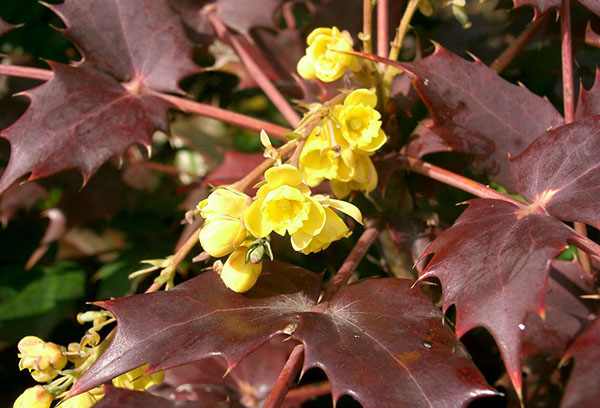
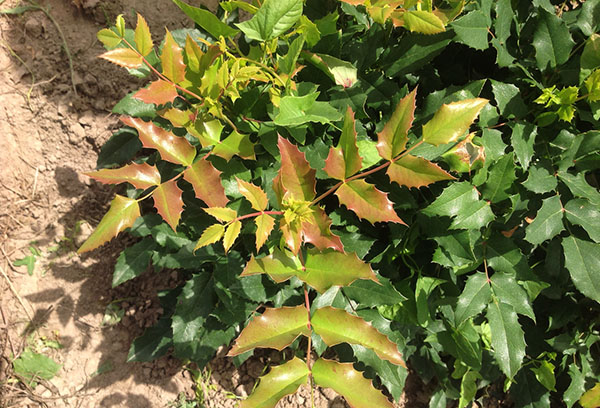
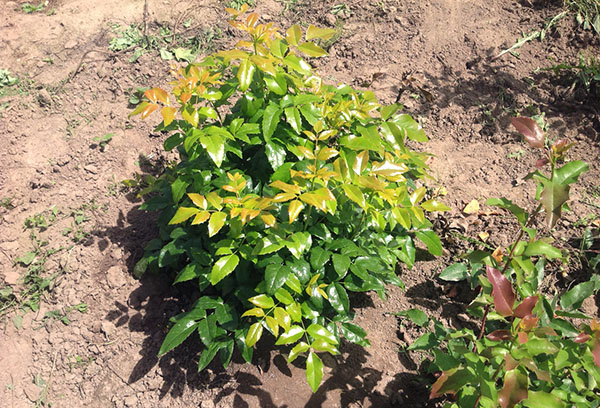
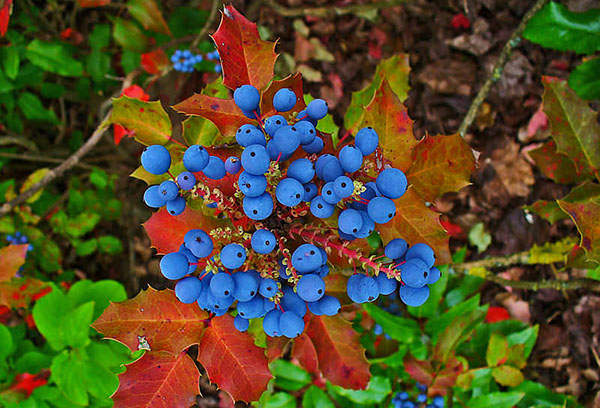
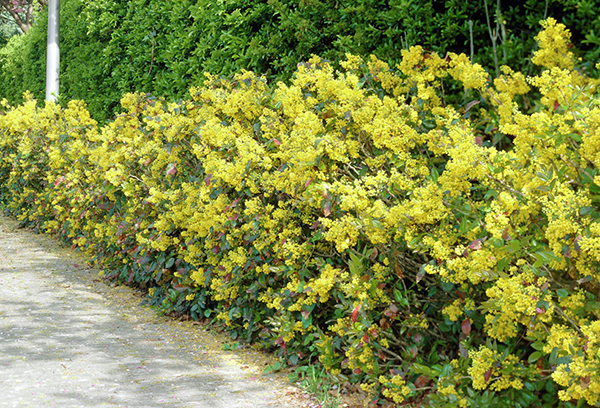
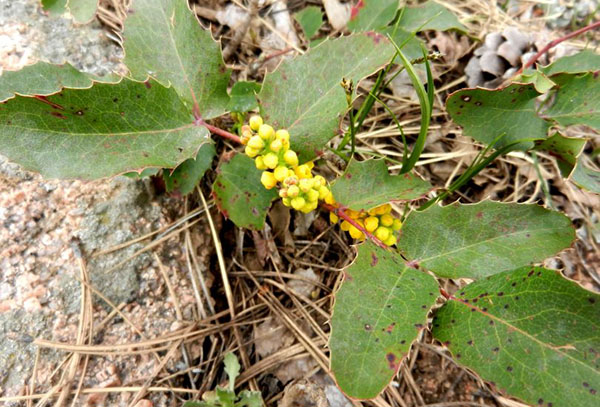
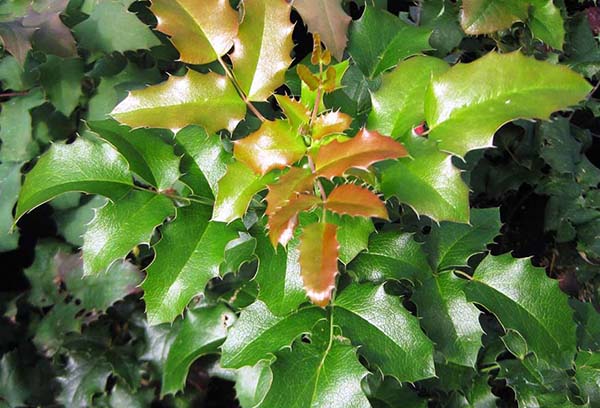
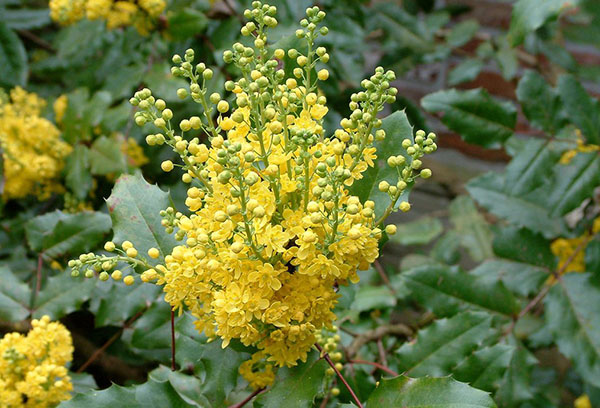
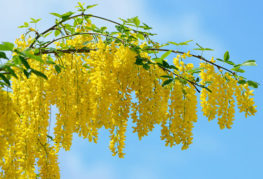
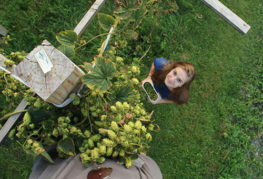
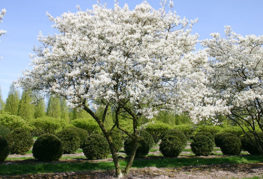

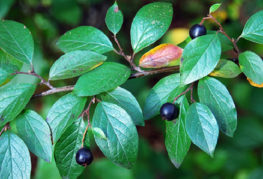
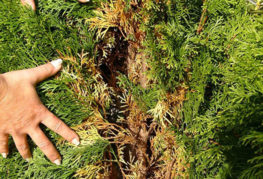
and will be published shortly.